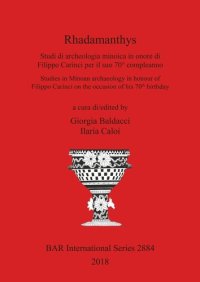
Ebook: Rhadamanthys: Studi di archeologia minoica in onore di Filippo Carinci per il suo 70° compleanno/Studies in Minoan archaeology in honour of Filippo Carinci on the occasion of his 70th birthday
Author: Giorgia Baldacci Ilaria Caloi
- Series: BAR British Archaeological Reports International Series 2884
- Year: 2018
- Publisher: BAR Publishing
- Language: Italian
- pdf
La presente raccolta contiene 33 articoli in italiano o inglese che, con differenti approcci e prospettive, si concentrano sull'archeologia minoica di Creta, estendendosi tuttavia anche al periodo neolitico e agli inizi dell'età del Ferro. Alcuni articoli presentano evidenze o materiali inediti, mentre altri contribuiscono al dibattito aperto su 'vecchie questioni' con nuove e aggiornate interpretazioni. Lo spettro dei temi toccati dagli autori è ampio: architettura, iconografia, produzione ceramica, paesaggio e territorio, cronologia assoluta e relativa, scritture, relazioni culturali, pratica funeraria, collezionismo e ricezione del passato minoico in età contemporanea. Diversi contributi hanno il loro focus geografico in Festòs, sede del leggendario regno di Rhadamanthys, e Haghia Triada, i siti sui quali si è concentrata l'attività di ricerca di Filippo Carinci. Nel complesso, il volume è una lettura essenziale e aggiornata sia per gli studiosi interessati alla preistoria dell'isola di Creta sia per quelli che si occupano di età del Bronzo in altre aree dell'Egeo. This book gathers together 33 original papers, in Italian and in English, which bring a variety of approaches and perspectives to the Minoan archaeology of Crete, including also the Neolithic period and the beginning of the Early Iron Age. Some of the papers present fresh evidence or materials, while others contribute to ongoing debates with new interpretations. The range of the themes touched by the authors is wide: architecture, iconography, pottery production, landscape and territory, absolute and relative chronology, scripts, cultural relations, funerary practices, collecting and modern reception of the Minoan past. Many contributions focus on Phaistos, seat of the legendary kingdom of Rhadamanthys, and Haghia Triada, the sites to which Filippo Carinci devoted his research activity. As a whole, the volume is essential, up-to-date reading both for scholars interested in the prehistory of the island of Crete and for those working on the Bronze Age of other parts of the Aegean.